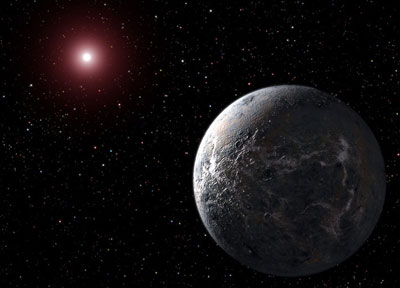Not-so-rare Earth?by Taylor Dinerman
|
| Sadly it seems that convenience, like politics, is a shaky basis on which to develop, or to believe in, a scientific hypothesis. |
Brownlee and Ward recognized the role that Jupiter plays in our Solar System as a comet and asteroid “catcher”, protecting the Earth and the other planets of the inner system from being hit by these bodies more often. They then asked, “How common are Jupiter-sized planets?” It would seem that they are pretty common. Since the mid 1990s, 270 exoplanets have been found, and 193 of these are described as gas giants, most of them bigger than Saturn. More are being found all the time. According to a 2006 NASA/JPL report on the science of the Navigator Program, the agency’s overall effort to search for exoplanets, “Over the past half decade the discovery rate has been steady at about 30 planets a year.”
Rare Earth made a logical case based on our planet’s combination of a large Moon (in some ways more of a dwarf planet than an ordinary moon), a powerful protective magnetic field, a location in the Solar System’s habitable zone (the “Goldilocks Phenomena”), and plate tectonics, to show just how unique it is. These factors combined, of course, with the presence of lots of water and just the right combination of minerals came together to produce what the authors called “Complex Life”, a cute term with no agreed upon scientific definition.
There is lots of evidence that our world is full of microbes that can live under very harsh conditions. These “extremeophiles” are the kind of uncomplex life that Brownlee and Ward think might be fairly common. Beyond that, they theorize that multicelled organisms are very rare indeed. “The gulf between the complexity of a bacterium and the complexity of even the simplest multicellular animal, such as a flatworm like Planaria, is immense.”
It should be recognized that they had good reasons for taking the stance they did. In 1996 the announcement that a meteorite from Antarctica had been found to contain potential evidence of past primitive life set off a frenzy of speculation and helped NASA to sell Congress on a program of Mars probes that continues to this day. Brownlee and Ward wrote that at that time, “In usually decorous scientific meetings, emotions boil over, reputations are made or tarnished, and hopes ride a roller coaster, for scientific paradigms are being advanced and discarded with dizzying speed.” They pointed out that “The evidence—at least from this particular meteorite—is highly controversial.” Their skepticism seems to have been a good idea.
The fact that they, and many other serious scientists, were right about the Antarctic meteorite does not necessarily mean that their Rare Earth is right. There is no hard evidence anywhere for life existing anywhere other than Earth. Brownlee and Ward may in the end be proven right, but that is no reason not to be as skeptical of their claims as they were of the claims made about the meteorite. David Darling wrote in 2001, “What matters is not whether there is anything unusual about Earth; there is going to be something idiosyncratic about every planet in space. What matters is whether any of Earth’s circumstances are not only unusual but also essential for complex life. So far we’ve seen nothing to suggest there is.” And so, as is proper, the debate will go on.
The search for life in our universe is not simply a question of hardheaded scientific investigation. If it were, it would hardly be worth spending time and money on. It involves profound philosophical, religious, and even political questions. The Rare Earth theory provided an easy set of answers that made a lot of very different people happy. It did no real damage to either side in the religious and cultural debates that are so much a part of our civilization. Those who stand in awe at the beauty of God’s creation could live with the results of the book, just as those who believe that its all some cosmic accident can do so.
Today those questions and similar ones are being debated more hotly than ever, and the case for scientific skepticism has never been stronger. If the Rare Earth hypothesis is breaking down, or at least fraying around the edges, it is perhaps because it was too neat. That’s the problem: nature never seems to deliver easy, cut-and-dried answers, or at least not since ancient times. Even then the answers, such as the ones that Archimedes found, were by no means obvious.
| The search for life in our universe is not simply a question of hardheaded scientific investigation. If it were, it would hardly be worth spending time and money on. |
Looking for scientific answers to the big questions is harder than ever. The effort strains the minds of some of the smartest men and women on Earth and it definitely strains the research budgets of even the richest nations. NASA’s 2006 report says, “To understand whether life is common or rare in the universe we must meet the technological challenges and embark on a series of complementary and interlocking explorations, each activity supporting and extending our efforts to characterize planetary systems and search for terrestrial planets and life.”
This search is going to be a very expensive proposition and is not one that NASA can afford with a major increase in its top-line budget. Without such an increase, the work will continue at only a fairly low level. If new money were made available the payoff would not only be in a greater knowledge of our universe, but the process of developing the technology for such a program would almost certainly result in better technology for the nation as a whole.
